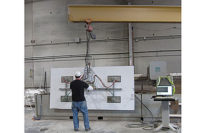Dan Riccolo, Morris Granite, Morris, IL: We send all of our small scrap to our next door neighbor. They have a 1,500-hp concrete crusher plant, [which we can use] free of charge.
As far as small remnants, pieces 6 inches wide get made into thresholds and shower curbs on consignment to flooring stores. We never have remnant sales, but do package remnants with full kitchens as a value-added incentive to clients.
We try to manage (and minimize) the negative impact remnants can have on sales, trying to turn each remnant into a profit, if at all possible.
Mike Dean, The Top Shop Inc., London, Ontario, Canada: For years, we had been paying for dump truck time to dump all of our scrap into the truck. It was hauled to a plant, where it was crushed and reused in B grade asphalt. More recently, a company nearby has bought a “stamper” and is taking all of our scrap for free. Free is good.
Sam Irvin, Sam’s Granite, Pisgah Forest, NC: Since I have a side business of my own — fabricating smaller granite items for retail sale — I routinely tour the local granite shops and “help” them get rid of their scrap. I then recycle it at my home shop into small home decor items.
Carmine Pantano, Frank’s Marble & Granite, Red Lion, PA: We keep larger remnants (vanity size and up) on our 2 acres of land for customers to choose from for remnant deals. Smaller pieces go into a large dumpster (stone only) and gets used by a local landowner for clean fill that he needs for the next few years.
We also get lots of craftspeople that go Dumpster diving and take pieces for their projects. We let them have these pieces for free as long as they get them on their own. Some people even use the small pieces from the Dumpster as pavers and/or stone walls.
Robert Carter, Albemarle Countertop Co, Charlottesville, VA: Like some of the others have said, we also keep any remnants down to 28 x 28 inches, and all long rips that end up 6 or so inches wide. All of the other scraps we palatalize, and a local farmer comes by every week or so and picks up a pallet. He has an old rock crusher that runs off of his tractor and he grinds the stone up and puts it on his farm roads.
He also takes the slurry left over from our Beckart water recycling system and uses that to pack in the rock chips in the potholes. I figure it is a good use for the stuff, it gets it out of our way, and it doesn’t cost a thing. In fact, he might just be saving me money. Years ago, we tried having a roll-off container dropped outside of our shop, and we ended up paying a small fortune to get it dumped. Never again. Sometimes we get the adventurous homeowner in that wants to lay a patio; I give them a pallet and wish them luck.
Chris Hildebrand, Affordable Quality Marble & Granite Inc., Aiken, SC: I palletize and sell for $100 a pallet. You get what you get.
Scott Kirkland, Laser Products, Romeoville, IL: We had a couple of tile-setters that used to buy all my waste for doing random mosaic patterns. They would flame them to get a texture. They would park a trailer at the shop, which we would load and call them when full. But I had to go to the tile stores to find a couple of guys who took to the idea. It kept us from having to pay to have it hauled off.
Kevin D. Noel, Century Stone, Sanford, NC: I’ve been in this business for six years, and we never have paid to dispose of our scrap. We put it on pallets at the saw. Then we set it outdoors, and it has been given away for free.
We have seen stacked wall flower beds, walkways in the gardens, pool surrounds, fill in concrete steps, etc. You name it, and they have done it. Only on occasion do we forklift it on. Around here, if it’s free, they’ll pick it up off the pallets.



